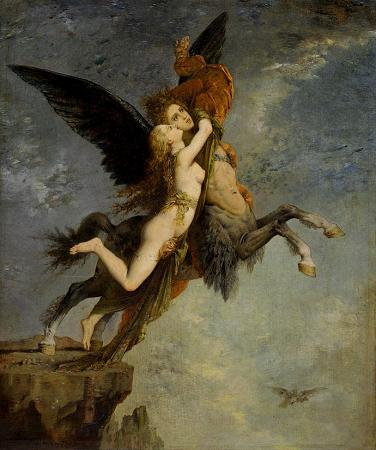Chimera. The Chimera, also Chimaera, according to Greek mythology, was a monstrous fire-breathing hybrid creature, composed of different animal parts from Lycia, Asia Minor. It is usually depicted as a lion, with the head of a goat protruding from its back, and a tail that might end with a snake's head. It was an offspring of Typhon and Echidna and a sibling of monsters like Cerberus and the Lernaean Hydra. The term chimera has come to describe any mythical or fictional creature with parts taken from various animals, to describe anything composed of disparate parts or perceived as wildly imaginative, implausible, or dazzling. According to Hesiod, the Chimera's mother was a certain ambiguous she, which may refer to Echidna, in which case the father would presumably be Typhon, though possibly the Hydra or even Ceto was meant instead. However, the mythographers Apollodorus and Hyginus both make the Chimera the offspring of Echidna and Typhon. Hesiod also has the Sphinx and the Nemean lion as the offspring of Orthus, and another ambiguous she, often understood as probably referring to the Chimera, although possibly instead to Echidna, or again even Ceto. Homer described the Chimera in the Iliad, saying that she was of divine stock, not of men, in the fore part a lion, in the hinder a serpent, and in the midst a goat, breathing forth in terrible wise the might of blazing fire. Hesiod and Apollodorus gave similar descriptions: a three-headed creature with a lion in front, a fire-breathing goat in the middle, and a serpent in the rear. According to Homer, the Chimera, who was reared by Araisodarus, was a bane to many men. As told in the Iliad, the hero Bellerophon was ordered by the king of Lycia to slay the Chimera. Still, the hero, trusting in the signs of the gods, succeeded in killing the Chimera. Hesiod adds that Bellerophon had help in killing the Chimera, saying, her did Pegasus and noble Bellerophon slay. Apollodorus gave a more complete account of the story. Iobates, the king of Lycia, had ordered Bellerophon to kill the Chimera since he thought that the Chimera would instead kill Bellerophon, for it was more than a match for many, let alone one. But the hero mounted his winged horse Pegasus, and soaring on high shot down the Chimera from the height. Although the Chimera was, according to Homer, situated in foreign Lycia, her representation in the arts was wholly Greek. An autonomous tradition that did not rely on the written word was represented in the visual repertory of the Greek vase painters. The Chimera first appeared early in the repertory of the proto-Corinthian pottery painters, providing some of the earliest identifiable mythological scenes that may be recognized in Greek art. After some early hesitation, the Corinthian type was fixed in the 670s BC; the variations in the pictorial representations suggest multiple origins to Marilyn Low Schmitt. Although the Chimera of antiquity was forgotten in Medieval art, chimerical figures appear as embodiments of the deceptive, even satanic forces of raw nature. They were depicted with a human face and a scaly tail, as in Dante's vision of Geryon in Inferno xvii.7-17, 25-27, hybrid monsters, more akin to the Manticore of Pliny's Natural History, provided iconic representations of hypocrisy and fraud well into the seventeenth century through a symbolic representation in Cesare Ripa's Iconologia. The myths of the Chimera may be found in the Bibliotheca of Pseudo-Apollodorus, the Iliad by Homer, the Fabulae 57 and 151 by Hyginus, the Metamorphoses, and the Theogony 319ff by Hesiod. Virgil, in the Aeneid employs Chimaera for the name of a gigantic ship of Gyas in the ship-race, with possible allegorical significance in contemporary Roman politics.mw-parser-output.hatnote{font-style:italic}.mw-parser-output div.hatnote{padding-left:1.6em;margin-bottom:0.5em}.mw-parser-output.hatnote i{font-style:normal}.mw-parser-output.hatnote+link+.hatnote{margin-top:-0.5em} Main article: Mount Chimaera Pliny the Elder cited Ctesias and quoted Photius identifying the Chimera with an area of permanent gas vents that still may be found by hikers on the Lycian Way in southwest Turkey. The vents emit burning methane thought to be of metamorphic origin. The fires of these were landmarks in ancient times and were used for navigation by sailors.
more...



